We’re back to Friday nights. Someone thought to move the tables outside. In the dimming light, we worked. Many things are on the task list.
We’re starting to work on a publication of sorts for How to Forget the Border Completely. It’s been a really clarifying decision to pull the strands of research we’ve been working on for the project together in a form that will allow the entire project to be read at once.
How to Forget the Border Completely is a series of tactics, stories, rumours, and inventions for disarming the border between Windsor and Detroit. We’re curious to understand how these communities might be different if we could find a way to dissolve our experience of the border. It would, likely, be too easy to just propose the erasure of the border infrastructure; rather, we’re imagining the impossible, trying to create a space for a conversation about the lengths to which we might have to go to re-establish a connection between these two cities.
This, in turn, necessitates the question — why is a connection important between these two cities? Why worry about another community at all when the one in front of us has so many things worth worrying about?
Two cities in such geographical, economic, and social proximity would be an interesting starting place in and of itself, but what begins to be articulated in being curious about Windsor and Detroit, specifically, is the temporal proximity — the ways in which a common history built on an industry has built up and broken down each place. When looking across the Detroit River, we can see one possible (city) future for Windsor. A declining population, a lost tax base, a city without a vision. Certainly, if we can look past all-too-momentary signs of recovery (we had briefly lost our ranking of the highest unemployment rate in the country, only to slide back down again), we can understand that Detroit is (or at least could be) our future.
Having grown up in the regional area, there was a particular reading of the Motor City that was shared by a large part of a generation. Detroit was once the obvious destination for Windsorites looking for up-scale shopping, culture, music, and so many day-to-day activities — at least this is the reading we have with the imperfect distance of more than 50 years — but then there were the riots. And nearly everything about the relationship of Windsor and Detroit was changed.
And yes, this is overly-simplified, and likely misread, but in creating that narrative from which we might begin to understand a recent history of two cities separated by a kilometer of water and an ever-thickening international border, we can start to shape a useful temporal, historical, and emotional starting point for creating our own understanding of Windsor and Detroit.
How to Forget the Border Completely is a response to our own anxieties and confusions around Windsor and Detroit. It’s a beginning. It’s a list. It’s a set of imaginary proposals, architecture, and infrastructure. It’s a conversation, and in a month or so, it will be condensed into a publication of some kind.
We’re working on a list of things to include in the publication — it involves working towards a micro-grant to fund border-crossers. Danielle has been rendering short-hand illustrations for the idea.
Josh has taken on the Canada Customs Consultancy we’ve proposed and started working on. We’re trying to figure out how Canadian Customs might improve their customer service. We’re taking on the language and tactics of other consultants in this endeavour. We’ll make Power Point presentations that will be absurd, but will in turn shift a conversation around increases in security policies and practices at the border. We’re curious about how seriously a consultancy like this might actually be taken within this kind of infrastructure to distract border-crossers into accepting further security protocols. Above, Fishy the Fish is one distraction.
A while ago, I saw this video and it became a valuable reference point in understanding how we might wrap this consultancy in the most useful language. Of course, we’re quite anxious to see how the consultancy will be passed around and read, and we figure that the closer we can come to being so embedded in this language, the more time we can steal in someone’s imagination as they briefly wonder if this could possibly be true, and if so, why customs officials might want to do it (and hopefully, maybe, with a bit more time, they might also wonder what current practices, infrastructures, and security measures are already masked in this way).
Around the table, we watch the video together.
And Michelle moves on to presenting Josh’s work on the border consultancy itself. Following examples of other custom service improvement metrics and training procedures from larger companies, this part of the consultancy will target front-line staff (the folks in the booths).
In parallel to work on HFBC, planning continues for CAFKA as Kevin and Hiba pull out the scale models from last week.
We know how we’ll move forward with the construction of the letters themselves for the most part, but we still need to determine how these 8-foot letters will stay standing up with very little support for a few weeks in a civic water feature.
The complexities are considerable. We want the focus of the work to be the letters themselves and perhaps even more than that, the ways in which they interact with the site of installation, particularly through photographs, rather than the supports.
In this way, we need to be cautious in how we build the infrastructural support — it needs to be strong, modular, and as muted as possible. Though certainly legible. Given the installation site and the work itself, it seems appropriate to gesture and acknowledge the need for supports, the behind the scenes things that hold everything together.
Kevin renders ideas for ways to install and secure the letter O.
We work with small bits of steel to understand how bracing might fit onto each letter.
And in turn, how each letter might fit into a base. Above, Hiba’s sketchbook trying to outline the build process.
We use things around us to try to figure out the most efficient and cost-effective method for supporting the installation.
A chalkboard becomes a lose approximation of how to hold up a large board without it tipping over. Kevin and I examine it in detail.
We move on to more drawings and come closer and closer to how we could envision this working. Next is a finalized budget so we can purchase and begin work. However, time is always a good proof reader. We’ll have to look at all of this again on Wednesday before making any commitments — the time has always helped in the past.
And then the night went on.
And then the weekend came, and Danielle and I stayed up excessively late talking about all of these projects. And now it’s Monday and I’m eager to spend vast amounts of time on all of this, because there’s so much to do and so much that can be done.
How to Forget the Border Completely is generously supported by the Ontario Arts Council.

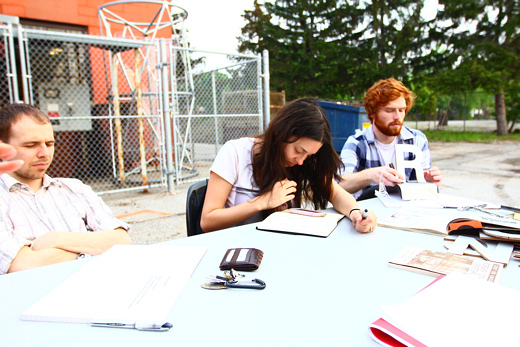
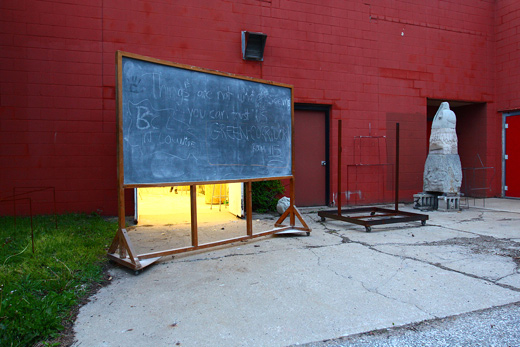
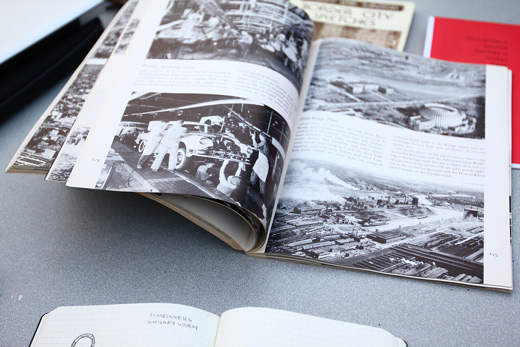


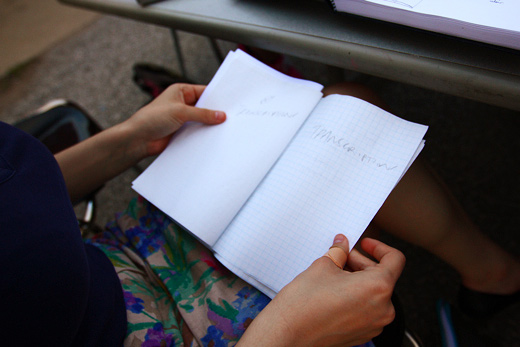


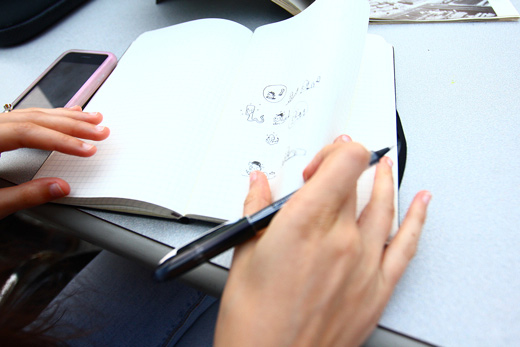
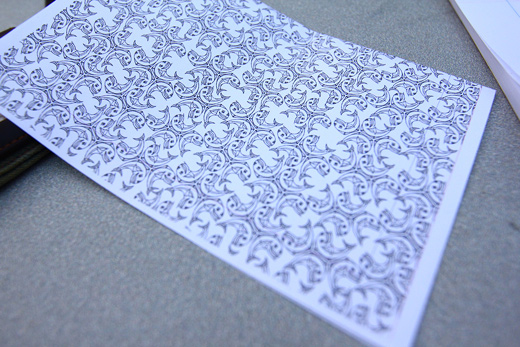

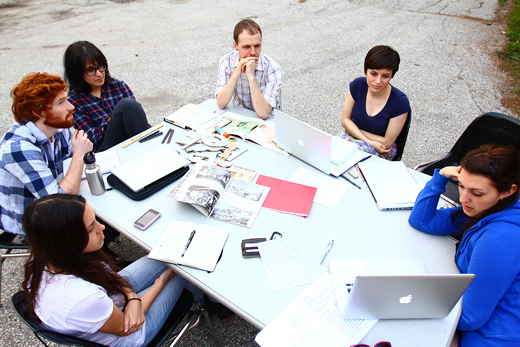

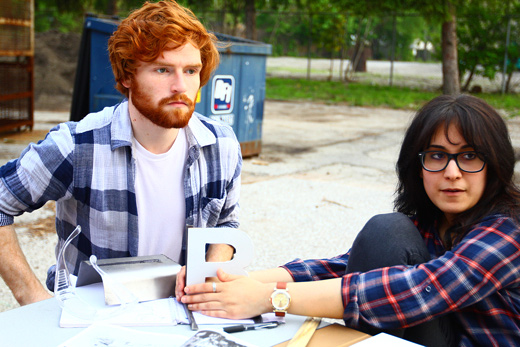
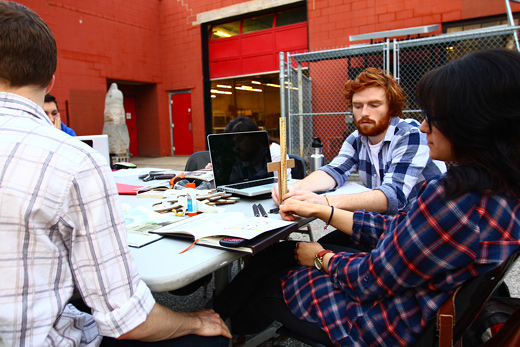
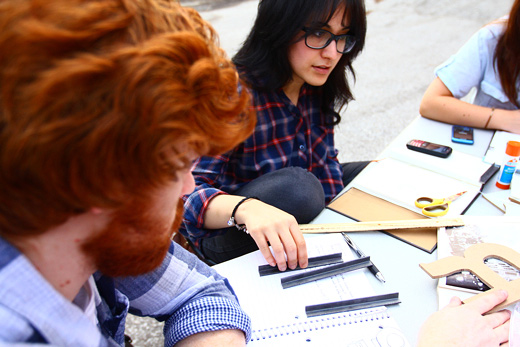
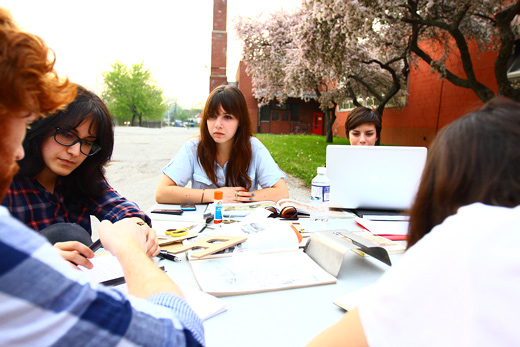
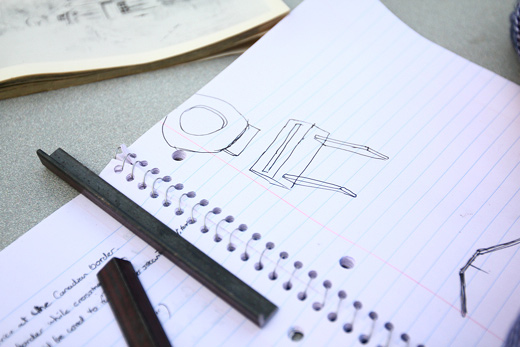
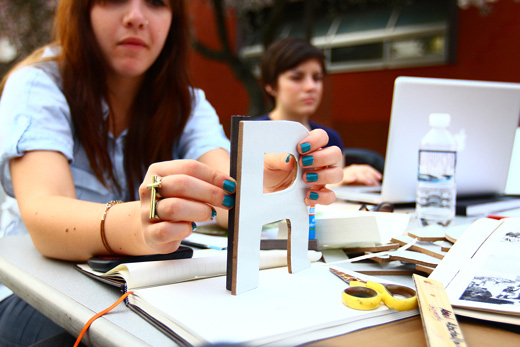

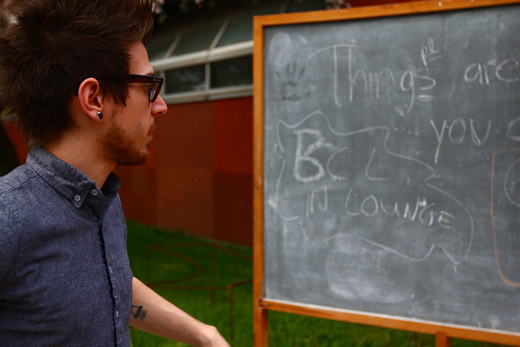
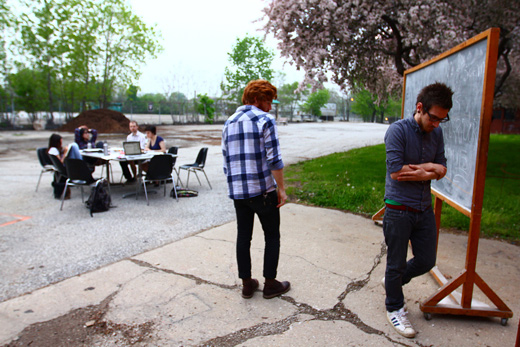
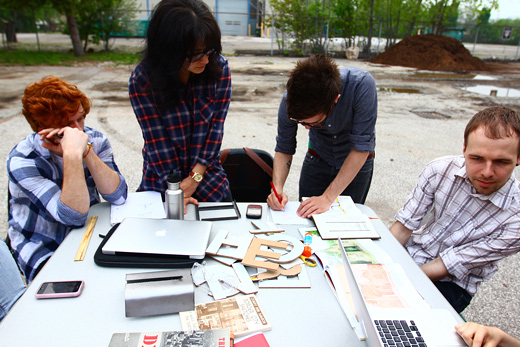
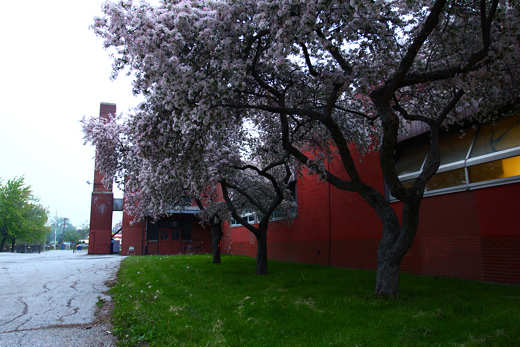
Outdoor meetings need to happen more often! It was really refreshing.
I agree, Josh. Also, this outdoor activity might lead to something spontaneous happening, hmmmm, like starting out on an adventure in the middle of everything. Fun ahead. See you tonight?
what kind of surface is going to be under the letters?
We’re mounting them in a pond 6″ deep. We’re still working on a final idea for how to keep them upright. Any suggestions?